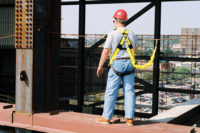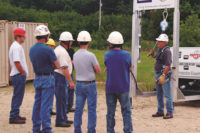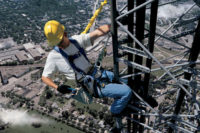Compatibility
Q: Can I attach two snap hooks to one D-ring?
A. No. Both ANSI and OSHA standards advise against attaching two snap hooks to one D-ring because the hooks may interfere with one another, causing one to disengage. Even if the snap hook is ANSI compliant (3,600-pound gate strength in all directions), attaching two hooks to one D-ring is not recommended.
Q: Can I attach two snap hooks together?
A: No. The size of the eye on one snap hook could cause the attached snap hook to roll out or release. Even if one or both of the snap hooks are ANSI compliant (3,600-pound gate strengths), this type of connection is unsafe.
Q: Can I attach a rebar/pelican type hook to a standard D-ring?
A: Yes, as long as the rebar/pelican hook meets current ANSI standards and is in good working condition. Check the markings on the hook and on the gate, which should indicate “3,600-pound gate strength” and reference the ANSI standard. Always check with the manufacturer to verify connections.
Q: Why can’t I attach my ANSI-rated hook to anything I want as long as the anchor is strong enough?
A: Having a 3,600-pound gated hook doesn’t mean you can attach to any object safely, even if it’s a 5,000-pound anchor. The hook must be able to turn or rotate to align with the direction of the load. If the hook is unable to do this, the frame of the hook and the gate may see unsafe loads.
Q: Can I attach a snap hook to a web loop?
A: No. The web can roll over onto the gate or portions of the lock on the hook and potentially cause the hook to release. Even if the hook is ANSI compliant, this type of connection is not recommended. However, it is safe to connect an ANSI-compliant carabineer to a web loop in most cases.
Fall Clearance
Q: I have heard that I need around 18 feet of clearance with a lanyard — that sounds excessive. How do the numbers add up?
A: First, remember that fall clearance distance is measured from the anchor point to the nearest obstruction. Then, use this basic formula to determine how much clearance you need:
Required fall distance clearance = Lanyard length + deceleration distance + height of worker + harness/D-ring movement (safety factor)
For example, the fall clearance required would be 17.5 feet with a six-foot person, a six-foot lanyard, four feet of allowable deceleration distance and 1.5 feet of harness stretch/D-ring slide (safety factor).
Q: How much clearance is needed with a self-retracting lifeline (SRL)?
A: It depends on the type of SRL, but normally you need approximately 6 feet. To determine how much clearance is necessary for a specific job, measure the distance from the surface you are standing on to the nearest obstruction. Some SRLs will have slightly less clearance requirements based on the type of energy-absorbing feature they incorporate and how quickly they engage. Always check with the manufacturer to verify the clearance required.
Q: In aerial lifts, how do I calculate my clearance when using a lanyard?
A: Start from the anchor point and follow the path the connecting lanyard would take in the event of a fall. For example, if the anchor point is inside the lift, measure from that anchor point upward over the edge/railing and then downward. Add up the lanyard length, height of the person, allowable deceleration distance and harness stretch / D-ring movement / safety factor. In some applications where the aerial lift is near the ground, a restraint system may be a better option.
Q: How much clearance do I need if my anchor point is at my feet?
A: Most standard lanyards and SRLs are not rated for attachment at foot level. Products rated for foot level connection have increased deceleration distances to handle the extra energy created in the free fall, and thus require added clearance.
For a lanyard rated for foot level connection, a clearance of 18.5 feet is required, measured from the anchor point to the nearest obstruction. Include the lanyard length, height of person, allowable deceleration distance and harness stretch / D-ring movement / safety factor.
Training
Q: If an employee takes a fall protection e-learning course or a computer-based training module is he or she considered trained?
A. No. OSHA requires employees to be trained by a competent person to recognize the hazards of falling and learn procedures that mitigate fall risks. They must not only display adequate knowledge, but also complete hands-on training exercises on how to properly select, inspect, anchor, assemble and use fall protection equipment, and attend physical demonstrations that simulate on-site conditions. Minimum requirements for fall protection training are outlined in the following standards and regulations: OSHA 1926.503(a)(2); OSHA 1926.503(c)(3); ANSI Z359.2 (3.3.1.5); ANSI Z359.2 (3.3.6.2); EM385.
Q: How often is refresher training required?
A. Federal training requirements are based on knowledge and not time. OSHA outlines specific circumstances when retraining is required, including changes on the jobsite or in the types of fall protection systems or equipment. ANSI, on the other hand, requires refresher training every two years in fall protection classes and every year for personnel assigned to perform rescues after a fall.
If you have reason to believe that a trained employee does not have the understanding and skill required, it’s your responsibility to ensure the employee is adequately retrained.
How did you do?
If you knew the answers to most of these questions, feel confident in your fall protection expertise.
If some of the questions stumped you, make an effort to improve your knowledge. The safety of your workers depends not only on them having the right equipment, but also the right information and training.



